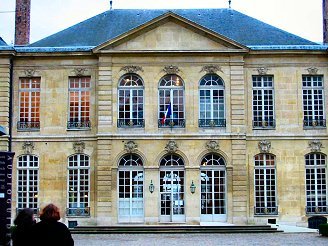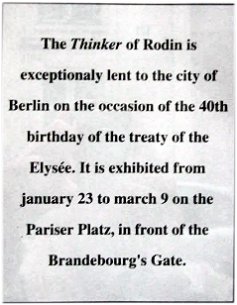Chapter 4: Two Tales of a City
Story One: No Good Deed Ever Goes Unpunished
This is not a funny story, but it is the kind of thing which you can only learn if you actually go to a place and talk to people who live there.
It is the story of The Flame at the end of the Pont de l'Alma (the Alma Bridge).
Here's what it looks like looking from the Right Bank across the Seine:
That's, actually, a pretty good shot.
Ok. So here's the interesting story about The Flame. It is an accurate copy of the flame which the Statue of Liberty holds atop her torch in New York harbor.
A copy of the WHOLE Statue of Liberty, if you're interested, is about a mile and a half downstream:
I couldn't get down to the little island to find out what that was all about but it fits with this story, so there you are.
This copy of The Flame was presented to the City of Paris in 1987 to honor the 100th
anniversary of the establishment of the
Herald Tribune in Paris (which, I believe was originally called the Paris Edition of the
Herald Tribune, and was changed to the International Herald Tribune when the Washington Post
and the New York Times bought into it (and ultimately all of it) in 1967.
The regular Herald Tribune was borne of a merger between the New York Herald (famous for
having sent Henry Morton Stanley to find Dr. Livingston, I presume) and the New York Tribune
(founded by Horace Greeley in 1841) in about 35 B.C. The Herald Tribune, until it folded in the '60's,
was the last major "broadsheet" competitor to the New York Times. The Daily News and the NY Post are both Tabloid-sized newspapers.
ANYWAY.
The International Herald Tribune, until this past December 31, was a joint publication of the Times and the Post. Earlier last year the NY Times big-footed the Washington Post by saying either the Post had to sell its half interest to the Times or the Times was going to stop participating and open its own international edition.
Muchly hard feelings ensued, but the Post blinked and now the International Herald Tribune is owned and operated by the NY Times. The Times owns some 16 newspapers in the US including biggies like the Boston Globe.
Each - I believe this is true - each of them has its own publisher and thus its own "voice." The
International Herald Tribune's senior executive reports to Howell Raines, the Executive Editor of the NY Times so it is, for all intents and purposes, a SECTION of the NY Times, not an independent newspaper.
Or so goes the theory from some of the former IHT employees who are now, again, writing for the Washington Post.
ANYWAY.
The Herald Tribune had this flame made and presented it to the City of Paris as a thank you note.
The City of Paris wanted no part of it. The City of Paris wanted no statues donated by no Americans to clutter up the landscape.
But, in the interests of international harmony (and adhering to the rule that one should "never argue with
the man who buys his ink by the barrel") the City of Paris relented and stuck on the north side of a secondary
bridge over the Seine, the Pont de l'Alma where the Avenue de New York runs into a tunnel.
In one of those twists and turns which history makes as it wends its way through our lives, that tunnel under the Pont de l'Alma bridge is, as it happens, the very tunnel through which Princess Diana's car was racing when it ran into the abutments and killed her.
Here's a look from the tunnel entrance:
As you remember, everything and anything connected to Diana became a shrine, as did the Flame. People from all over the world showed up and put flowers at the base of The Flame to commemorate the place where the accident took place.
Flowers are gone (as the result, some say, of the IHT people complaining) but graffiti on the wall next to The Flame remains:
The International Herald Tribune's gift to the City of Paris is now far better known as "Diana's Flame" and, indeed, most people think it was erected in commemoration of the accident which killed her.
Story Two: Another Trip to the Louvre.
This is another one of those situations in which I find myself through, absolutely no fault of my own.
As you know the logo for Mullings is this drawing:
Which is a representation of the famous statue "The Thinker" by Rodin (pronounced as "Roh-da")
Thinking about "The Thinker," I think "As I'm in Paris, why don't I take a trip back to the Louvre and take some photos of the actual statue and maybe work it into a revamped web page.
So. I hopped on the Metro (I can now say, "Where is the Metro" in French which is: People seem very pleased to tell me. I think they're pleased. They seem to be smiling. I wonder what the difference is between a smile and a grimace?
ANYWAY.
I am, as you know, the world's most expert user of public transport in foreign cities. I'm pretty good in Washington, DC, too, but it's more fun on the Paris Metro where there are signs (in English) warning you to look out for pickpockets. Wearing pants, a suit jacket, and a raincoat, plus my non-European-travel-all shoulder back I have a LOT of pockets to pick, so I am very careful of those around me.
As I have mentioned before I keep my suit jacket and my raincoat buttoned. If someone can get into my FRONT pants pocket (where I secret my wallet under all that material I guess he's earned the lift.
I hopped on the Metro at Pont de l'Alma, changed at Charles de Gaulle, changed again at Franklin D. Roosevelt (where I got a kick out of this:)
As I have been to the Louvre before, I walked right past all the shops, went directly to the bag X-ray machine, put my five Euros into the automatic machine and got my ticket, went to the coat check and unloaded my raincoat and scarf; went to the place where you can rent a thing to tell you what you're looking at (another five Euros) and set out to find the Rodin statues.
The Louvre has gallery charts in many languages including English. But it doesn't matter. You can't figure you where the devil you are in any language.
I started out in the medieval area in which I took this photo:
The thing about the audio device is this: Every work of art and display is not described. Only a few are. There is no guide to tell you which works have an audio description which, in the beginning I found irritating.
However, after a few hits, when I came across a work with a four-digit number next to it (indicating there was an audio description) it was like discovering another present hidden amidst the wrapping paper on Christmas morning.
I looked at statue after statue after statue. I already showed you that photo that I took in the "Hall of Men Posing Without a Stitch of Clothing On." Then I came across this:
This, as they used to say in dime novels, gave me a start! It gave me a start because she (one of the "Muses") looks EXACTLY like my third grade teacher, Mrs. Moore. It looks like the clothes she wore. This is how big she looked to me. And that was my head she was
carrying in her hand except I don't remember shaving in the third grade but this guy didn't shave, either (and look what happened to him!)
I don't know exactly how to say "I high-tailed it out of there" in French - or why you would want to - but that's what I did.
I happened to come across the famous statue of Venus so I took this photo which is one of about 347 million which have been taken
of her each exactly like the one before it and the one after.
A couple more then I'll get back to the story.
This should be on the desk of every single person in Washington, DC. As a reminder.
And finally, this:
I'm going to send this back to Washington and tell them I've settled on the decorating scheme for my O*F C*O*U*N*S*E*L office.
ANYWAY.
I finally found the hall called "French Sculptures."
Whew. At long last. I walked around and around but didn't see "The Thinker." I mean, where would they put one of the most famous statues in the world by a French sculpture, if not in the Louvre?
I stopped by a 146 year old guy who seemed to be a museum employee - after first determining he was not a French Sculpture - and pointed to my chart and asked, "Rodin?"
He looked up at me. Pulled out a pen and wrote on my chart: "Musée Rodin - Rue de Verenne."
What does "Imbicile" mean in English?
Rodin has his OWN museum? Aw, man! My feet hurt and it's late in the day and I'm in the wrong museum.
Drat.
"Ok," I think to myself, "I'll go there tomorrow."
When I got back to the Best Western (here I am, by the way, in the lobby with the Manager):
Vie-Oh-La! It doesn't look like it's too far a walk from the old BW.
The next morning I began to make my way over to Rue de Verennes to get this photo of The Thinker upon which I am now fixated.
It was farther than it looked like it was going to be on the map. On the map it was only about four inches away. In real life it was way, WAY farther than that.
But, I was on a mission. Along the way I happened to run across the new French fortifications against an invading Iraqi Army:
And, still, like Cary Grant in that movie when he was a member of the French Foreign Legion (Gunga Din, I think), I kept walking.
I was getting close to my quest: An actual photo of the actual statue of The Thinker.
I turned right, as the sign suggested, went around the corner and Here's what it looks like from the front gate:
But, there was something wrong. I thought The Thinker was right out in front of the building.
Ah, maybe I was wrong. Maybe they take it in when it rains - yeah, right. You could write a travelogue
about January in Paris and every third graf type "and then it started to rain."
Or. OR! Maybe it's in the garden BEHIND the museum so you have to pay your good money to go in.
I stepped up to the window to fork over my five Euros when I saw a sign tacked up on the wall like a
note from Martin Luther:
I know the Germans walked from Berlin to Paris; but I decided that walking back to the Best Western front would be far enough.
And those are my Two Tales of a City.
Click here to return to the Secret Decoder Ring page
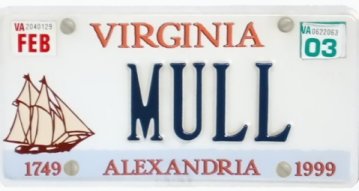

We'll Always Have Paris





"W H E R E ... I S ... T H E ... M E T R O?")

and got off at the Louvre-Rivoli stop which lets you out right under the museum.
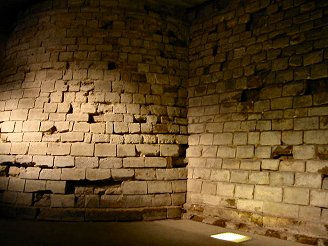
because it is the oldest part of the Louvre and because I could then ask you to compare and contrast that with the newest part of the Louvre which is the idiotic glass pyramid sticking up in the middle of the courtyard. Here, it is seen from the floor of the museum looking up:
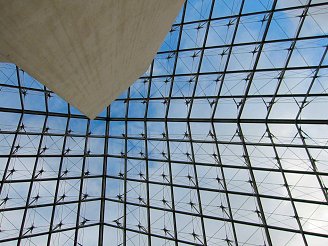

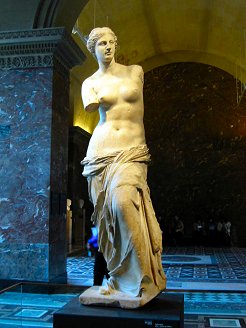
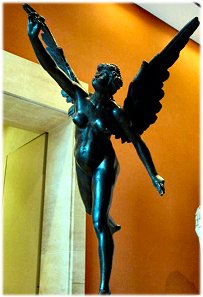
This is a statue called "Fame," which I liked because (although you can't see it in this shot) she he holding the flute of good news in her raised hand and the flute of bad news in her lowered hand.


I got out my handy-dandy fold-up map and found Rue de Verennes.
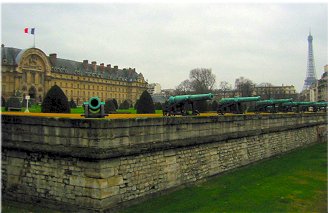

Vie-Oh-La again! There it was, the Musée Rodin!
